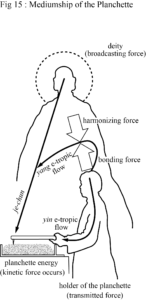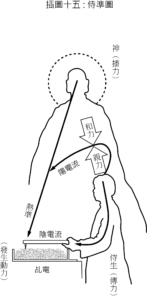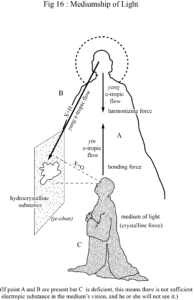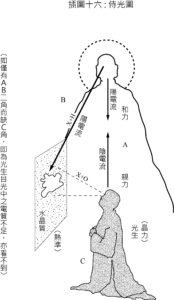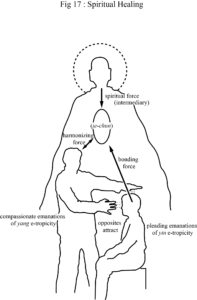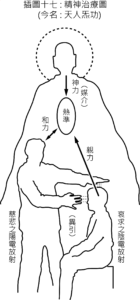第二節 親和力之關係
Having looked into the spirit realm, one may now ask: Is there any way for humans to make connection with this realm? The answer is that cultivating bonding and harmonizing forces (sympathetic force) is sufficient.
靈界之狀況明矣,人類欲求與此靈界中發生一種關係,究有何法乎?曰:培養其親和力足矣。
Bonding and harmonizing forces are an attraction of opposites as an effect of e-tropicity. This is because human thoughts are an emanation of e-tropicity. If these thoughts are emitted in a disorderly manner, they will go in all directions and end up as nothing. When given focus by mental concentration, with time they will cause an response in the e-tropicity of what is focused on. The two kinds of e-tropicity interact, and a harmonizing force arises. Thus if what A’s thoughts emit is yin e-tropicity, this is a bonding force. This bonding force focuses on its object, and the yang e-tropicity in its object attracts it (attraction of opposites), which produces harmonizing force. Therefore, there have been ideas of mind-to-mind response since ancient times. In our religion and in Christianity there is prayer. Confucians have their sacrificial offerings “make offerings as if spirits were present”. Taoists and Buddhists chant scriptures and say mantras. All are examples of spiritual response. But in order for sympathetic forces to arise, these must be done with an utterly sincere heart. Only by praying devoutly, pouring one’s spirit into it and concentrating each thought, can one’s e-tropicity reach a certain je-chun [critical energy] and be emitted. This is what is meant by “sincerity creates efficacy.” Otherwise it will end up ineffective. It is not that the spirits lack efficacy, but because one is not sincere. In the whole universe, only sincerity is the most precious. The origination of sympathetic force is nothing but a physical result of sincerity.
親和力者,異性相引之電力作用也。蓋人類之思想,即為一種電力之放射。此種思想如任其散亂放出,即投向四方而歸於虛無。若專心集注凝向一點,則久而久之,即能引起其所集注對象之電力的反應,兩電相交,乃有和力之發生。是故由甲之思想所射出者,若為陰電,即屬一種親力。此種親力凝向其對象,其對象中之陽電即與之相引(異引)而產生和力。是故心理感應之說,自古有之。本教及基督教之祈禱,儒家之祭祀(祭如在,祭神如神在),道教佛家之誦經持咒,皆以此也。然親和力之形成,必須以「至誠之心」為之。蓋惟有虔誠祈禱,精神貫注,念念集中,其電力方能達到一定之熱準而發射放出,即所謂「誠則靈」是也。否則即歸無效,非神不靈,不誠故也。天地之大,惟誠為貴。親和力之產生,「誠」之物理的結果而已。
A. Sympathetic force between human beings: Let us illustrate this with a brief evidence. As discussed earlier, the e-tropic substance contained in human harmonons is actively firm, congenial and compassionate, while the e-tropic substance in e-tropons is passive, malicious and intractable. Also, the e-tropicity emitted by harmonons is spontaneous, without ulterior motive, intuitive. The e-tropicity emitted by e-tropons is to gain something; it is unnatural and on purpose. Thus thoughts that one entertains for a purpose are mostly yin e-tropicity, what we call a bonding force. If one person seeks something from another, he will give off pleading, expectant e-tropicity. Once such yin e-tropic emanations are directed toward their object, if the other party responds with force of compassion and kindness, this will be a yang emanation, which will set up an attraction of opposites. This person will thereby get the hoped-for sympathy or help. Conversely, if the other party also responds with yin e-tropicity, then like will repel like, and the person will sense a slight or insult. There will be no sympathetic force. Another example is a butcher slaughtering a sheep. Though the sheep may bleat pitifully, the butcher has killing on his mind. The e-tropicity of both man and sheep is yin, so no harmonizing force can arise, and the sheep must be butchered. On the other hand, if the miserable wails of an animal (bonding force) arouse human sympathy, emotions of pity will arise from interaction of the animal’s bonding force and the human’s harmonizing force. This can be simplified to the following formula:
甲、人類相互間之親和力—以簡明之例證之,如前所論,人類和子所含之電質為陽剛的、和善的、慈悲的;電子中之電質則為陰柔的、惡意的、邪慢的。又和子之電力的放射,為自然的、無為的、直覺的;電子中電力之放射,則為有為的、不自然的、存心的。故凡有心而為之思想,多屬陰電,即所謂親力是。如人有求於他人,即放出哀求期望之電射,此種陰性之電射投向其對象之後,如對方應以慈悲和善之力,即為陽性之電射而成立異引,其人遂得其冀求之同情或幫忙。反之,如對方亦以陰電應之,則同性相排,其人所感覺者,即為凶慢或侮辱,而親和力不能成立矣。又如屠夫殺羊,羊號慘然,然此時屠夫心中充滿殺性,人羊之電皆是陰性,所以不能發出和力,而羊卒不免被屠。反之,如動物哀號呼痛之聲(親力)引起人類之同情,此種惻隱之心,即由人類之和力與此動物之親力相交而發生,故其公式,可約如下:
(1) Bonding force + bonding force = bonding force = like repels like
(2) Bonding force + harmonizing force = sympathetic force = attraction of opposites
(3) Harmonizing force + harmonizing force = opposing force = cancelling out of energy
⑴親力+親力=親力=同排
⑵親力+和力=親和力=異引
⑶和力+和力=抗力=抵消
Thus the relation of bonding force and harmonizing force among human beings is same with the Buddhist notion of yin-yuan(因緣)[causal affinity]. Suppose that A gives generously to both B and C, the following results can occur:
是故人類間親和力之關係,與佛說之因緣,實即一事。例如甲生以佈施予乙丙二生,其所得之結果為:
B receives A’s gift and is moved (bonding force): a cause is present. C is not moved (no bonding force), and there is no cause.
乙以為甲有惠施我,當以酬報而動其心(親力)—是即為因;丙不動心(無親力)是即無因。
Meanwhile, A’s giving is done intentionally. Being aware that he is giving, his harmonizing force arises. This harmonizing force and B’s bonding force attract each other, giving rise to affinity. But C is unmoved by A’s giving. Though A has the intention, on C’s side there is no cause, so there is only bonding force with no response. The affinity is not established. Thus the principle is as below:
而同時甲之佈施,亦屬有心,以為我施,即生出和力,此和力與乙之親力相引,乃生出緣。但甲施丙,而丙無動於心,甲雖有意,然丙無因,因此祇有一種親力,而無響應,即不結緣。故其定律,又可如下:
If cause is present on both sides, then affinity is formed. If the cause is not present on one side, affinity is not formed. Mutual response between good notions is different than response between evil notions, and therefore there is a distinction between casual affinity and harmful affinity.
雙方有因結為緣,一方無因不結緣。因善念與惡念相應之不同,而分別結為因緣或孽緣。
If the two sides attract each other with ill intent, a harmful affinity is thus formed; two good intentions attracting each other form a casual affinity. One good and one evil do not form a casual affinity. If one side has evil notions and the other still responds with good, the e-tropic substance emitted from the good is buoyant (being emitted from harmonons) and rising, while the e-tropic substance emitted from the evil is heavy and sinking. The two being in a state of imbalance, they do not form an affinity. Thus the relationship of bonding to harmonizing forces can be expressed by the following overall law:
故如有兩惡意相引,即結為孽緣;兩善意相引,即結為因緣。一惡一善不結緣,兩善意相引即結為因緣,蓋如一方有惡念,而他方仍以善念應之,則善者之電射質輕(係發自和子)而上昇,惡者之電射質重而下墜,即處於不平衡之狀態,不平衡故不結緣也,是以親和力之關係,又可為總定律如下:
Individuals cannot form affinity unless they exist in a state of balance. This is because their harmonon and e-tropon emanations do not reach je-chun, and cannot transform.
緣者非處於平衡狀態之下,不能結緣,因其和子電子之放射皆未達到熱準,不能發生變化故也。
B. Sympathetic forces between humans and harmonons: Bonding and harmonizing forces that arise between humans are not a difficult matter. More advanced are the bonding and harmonizing forces that arise between humans and harmonons. This is a response of casual affinity between the physical and the non-physical. Here let us first discuss the bonding and harmonizing forces which can arise between humans and free harmonons. Suppose a woman prays night and day that the soul of her deceased child will come back to be reincarnated. From the woman’s side a bonding force will certainly be emitted toward the locus of that harmonon. If the harmonon yearns for the mother at the same time, then a harmonizing force will arise which can draw this harmonon to the woman’s location, where once again become it will become her child. But if the harmonon has no wish to respond, the woman’s bonding force will be cast into space without effect. And even if there is an effect, it is extremely difficult for anything to be accomplished. This is because the intentions of harmonon are confused, and behavior is ungoverned. It is not easy for harmonon to link up with e-tropicity of living persons. As for interactions where there was no family relationship, this is even harder. (Family relations usually involve e-tropic substance with the same qualities.) Confucians, when they make their sacrificial offerings, also emphasize family relations. (Yin e-tropicity emitted by the celebrant is similar to e-tropic substance in the harmonons offered to).
乙、人與和子之親和力—人類相互間所發生之親和力,淺近事也。進一步則為人類與和子間所發生之親和力,即有形對無形之因緣感應是也。茲先論人類對於自由和子所能產生之親和力,如今有某女日夕禱祝其已死亡之子女再來投生,則在某女之方面,自有一種親力射向該和子之處,如該和子同時亦在想念其母,則有和力之產生,而能引至某女之處,重為彼之子女。但如該和子無心響應,則某女之親力投向空處,而不能發生效應,但即有效應,亦極難成事。蓋和子之心意混亂,行為無主,實不易與生人之電力銜接故也。至於無親屬關係之交接,則更難矣(親屬關係多少含有同一質素之電質)。儒教之崇祀,亦重親屬關係(祭祀者所發出陰電與被祭之和子之電質相同)。
C. Sympathetic forces between humans and deities: Next are the sympathetic forces between humans on one hand and freed spirits, deities or buddhas on the other. The difference between freed harmonons and deities or buddhas is the relatively greater powers of the latter. Deities and buddhas are not only free, they can also approach humans by their own choice. Thus humans need only nurture their bonding force till it reaches a certain je-chun, then they can attract the harmonizing force of deities and buddhas. When such a person passes away, the deities or buddhas will descend to the vicinity of the isothermal zone to receive him. Using e-tropic force they will lift him to his proper place. Christians wish to go to Heaven, and Buddhists seek rebirth in the Western Paradise. If their thoughts are sincere, they can draw harmonizing force from Jesus or Amitabha and be taken up to that place. Though the idea is wondrously mysterious, the principle is quite simple. It is merely an attraction between differing e-tropicity of bonding and harmonizing forces. As for those with attainment in spiritual practice (see “Tempering of the Spirit” below), relying on one’s own power in seeking the sacred realm is different than seeking help from an outside force with which one bonds.
丙、人與神之親和力—次之,即為人與自由神以上神佛間之親和力。神佛與自由和子不同之處,即神佛具有較大之能力是也。神佛不但可以自由,且能自主而接近人類。故人類但須培養其親力,以至相當之熱準,即能引來神佛之和力,至其逝時,則由神佛降至同溫層附近加以接引,然後由電力將其挾至其應到之處。耶教徒求登天堂,佛教徒求生樂土,如其念誠,即可引來耶穌、阿彌陀佛之和力,而將其挾至彼處。意雖玄妙,理實至簡,親和力之異電相引而已。至於具有修持功夫者(詳後「精神之鍛鍊」節),則為憑其自力以求達到聖域,與仰仗親和力之相引他力者固不同也。
This being so, methods for humans to nurture the bonding and harmonizing forces between themselves and higher beings fall within these three types:
職是之故,人類培養其親和力之方法,實不出下列三種:
1. Do deeds of merit and virtue in this world, and become a freed spirit after death.
一、立功德於世,逝後即為自由神。
2. Increase one’s bonding force to attract harmonizing force from the deity or buddha that one wishes to approach, and thereby ascend to a higher realm.
二、增加親力,引來其所親近之神佛的和力,而得昇至較高之境界。
3. Temper the spirit and seek to arrive at a new natural environment after passing away. By relying on one’s own strength one will enter different post-death realms, permitted in accordance with different attainments in spiritual practice.
三、鍛鍊精神,以求自力達到適應其逝後之新的自然環境之理想,而依其修持力之大小,逝後進入不同之境界。
D. Narrowing the gap between Heaven and man: Based on the above discussion, it is plain that the endeavor of human beings in their physical bodies to interact with the non-physical spirit realm has truly been going on since ancient times. However, human knowledge in the past was more oriented toward individual cultivation and mystic philosophies. It has not yet been pursued systematically. Time has brought great advancement in the sciences, and discoveries in acoustics, optics, electricity and chemistry have gradually revealed truths of the cosmos, gradually securing the road to further communication between Heaven and man. In the future, as science and philosophy advance in unison, more will be gained with less effort. This will hasten the advent of unity between Heaven and man. We are watching expectantly for this, and working to realize it.
丁、天人之接近—基上所論,人類要求以有形之體,以與無形之靈界相互交接之努力,可謂自古即進行不已。惟往古人類之智識,較偏於個人修持及玄理方面,未能加以系統之追求。降至今日,科學大昌,聲光電化之發明,已將此宇宙間之真理逐步揭曉,更予天人交通之途以有力之保證。將來科學與哲學配合進行,尤可事半功倍,以促成天人大同時期之早日到來,吾人可拭目以待之,努力以實現之。
A brief account of methods for Heaven-man communication is given below, with hopes to initiate a move toward scientific improvement: Mediumship of the planchette, mediumship of light, mediumship of the pen, auditory mediumship, spiritual healing(cosmic ch’i healing), and quiet contemplation.
目前姑將天人交通方法之原理簡析如左,以期引起科學上改良之運動:一、侍準,二、侍光,三、侍筆,四、侍聽,五、精神治療,六、靜觀。
1. Mediumship of the planchette: Mediumship of the planchette is receiving a broadcast from the spirit realm to the human world. The spirit-medium is the transmittal force, the planchette localizes the e-tropic force, and the deity serves as the broadcasting force. Transmitted force (bonding force) reaches out to the broadcasted force (harmonizing force) above. The two stimulate each other, initiating e-tropic kinesis in the planchette. Thus, it must draw on a person’s bonding force before the harmonizing force can have an effect. Given one side in isolation, this will not be possible. The person who acts as transmittal force (the spirit-medium) must meet the following conditions to qualify: (1) It is best that the medium is a virgin child (due to the relative strength of e-tropic substance in a child’s harmonons); (2) The medium must have personal qualities of devotion and constancy; (3) The medium must have a certain degree of intelligence, or the effect is not likely to be significant (like Fig.15).
一、侍準—侍準者,靈界對人間之廣播也。侍生為傳力,準筆為電力,神為播力,傳力(親力)上應播力(和力),兩力相感,乃生準筆之電動力,故亦必須借人之親力,而後方能有和力之作用,一方獨立不可能也。惟擔任傳力之人(侍生)則必須具備下列條件方合要求,⑴最好為童子(因其和子中之電質較強故),⑵須具虔誠而有恆心者,⑶須有相當才識者,否則效果不易顯著也(如插圖十五)。
2. Mediumship of light: Mediumship of light is a movie beamed from the spirit realm to human beings. The medium of light serves as the crystalline force; the lightscreen is the deflecting force; and the deity is a projecting force. The principle is that of attraction of like to like. That is, factor-X and oxygenic essence in the medium’s harmonon mix to become bonding force (yin e-tropicity). On the other side, factor-X and hydrogenic essence from the spirit realm join to make harmonizing force (yang e-tropicity). The two combine into a hydrocrystalline matrix. Thus it can deflect the light from the screen to be perceived by the eye. (Hydrogenic and oxygenic essences are the precursor substances of aqua essentia. X is an e-tropic element. The three elements go together to make a crystalline matrix that deflects light to the eyes, like Fig.16.)
二、侍光—侍光者,靈界對人類所放之電影也。光生為晶力,光布為折力,神為攝力,其原理為同性相引,即由光生和子之X原素+O°等混合為親力(陰電),一方靈界亦以X原素及H°配為和力(陽電),兩相化合為一種水晶質,故可折光於布而能感於目(H+O為化水元素,X為電素,三元相交而生晶體反折於目,如插圖十六)。
3. Mediumship of the pen: This is similar in principle to that of the planchette, but more difficult in practice.
三、侍筆—侍筆之理與侍準同,惟較為困難耳。
4. Auditory mediumship: This is also a transmission from the spirit realm to human beings. The principle still needs to be verified.
四、侍聽—侍聽亦為靈界對人間之廣播,其理待證。
5. Spiritual healing: This is accomplished by adding the effect of human-divine sympathetic forces to the sympathetic forces between humans. The key is that both patient and healer need to put forth the utmost sincerity. Only then can it reach je-chun and take effect. Otherwise it will be ineffective. This is shown in Fig.17.
五、精神治療—精神治療者,人類之親和力加人與神之親和力之作用而成也。其要訣為求診者及治病者均須竭誠為之,方可達到熱準而生效,否則無效也(如插圖十七)。
6. Quiet contemplation: Quiet contemplation is sitting meditation, as in Ch’an (禪), carried to the highest level. It proceeds through settling, quietude, tranquility, and reflection to the true realm of attainment. This is what Taoists call “penetrating into spirit” and Buddhists call “seeing one’s original nature.” Only at this stage can humans communicate directly and by their own power with spirits. But such sudden enlightenment requires profound practice in quiet meditation. There is no other way to experience it for oneself.
六、靜觀—靜觀為禪坐功夫已臻上乘,由「定」、「靜」、「安」、「慮」而至「得」之真實境界,即道家之所謂「通靈」,佛家之所謂「見性」,始能達到人神直接的自力交通,惟此種頓覺,必須「靜參」工夫深邃,方可躬親體驗耳。

